Table of Contents
- Introduction
- Editor’s Choice
- Contact Center Analytics Market Statistics
- Primary Industries of Contact Centers Worldwide
- Geographical Distribution of Contact Centers Worldwide
- Contact Center Analytics Applications Statistics
- Use of Artificial Intelligence (AI) at Contact Centers Worldwide
- Use of Generative Artificial Intelligence (GenAI) at Contact Centers Worldwide
- Factors Impacting the Contact Center Industry in Various Services
- Role of Contact Center Leadership in Customer Experience
- Consumer Satisfaction
- Regulations for Contact Center Analytics
- Innovations and Developments in Contact Center Analytics Statistics
- Recent Developments
- Conclusion
- FAQs
Introduction
Contact Center Analytics Statistics: Contact center analytics focuses on collecting, analyzing, and interpreting customer interaction data to improve operational efficiency and enhance customer experience.
Further, It encompasses various components, including data collection from multiple channels. Key performance indicators (KPIs) like Average Handle Time and Customer Satisfaction Score, and the use of descriptive, predictive, and prescriptive analytics.
Techniques such as text and speech analytics employ natural language processing to extract insights from unstructured data.
Reporting tools, like interactive dashboards, facilitate real-time performance monitoring, while actionable insights support continuous improvement.
Ultimately, integrating analytics with CRM systems provides a holistic view of customer journeys. Helping organizations adapt to changing expectations and maintain a competitive edge.
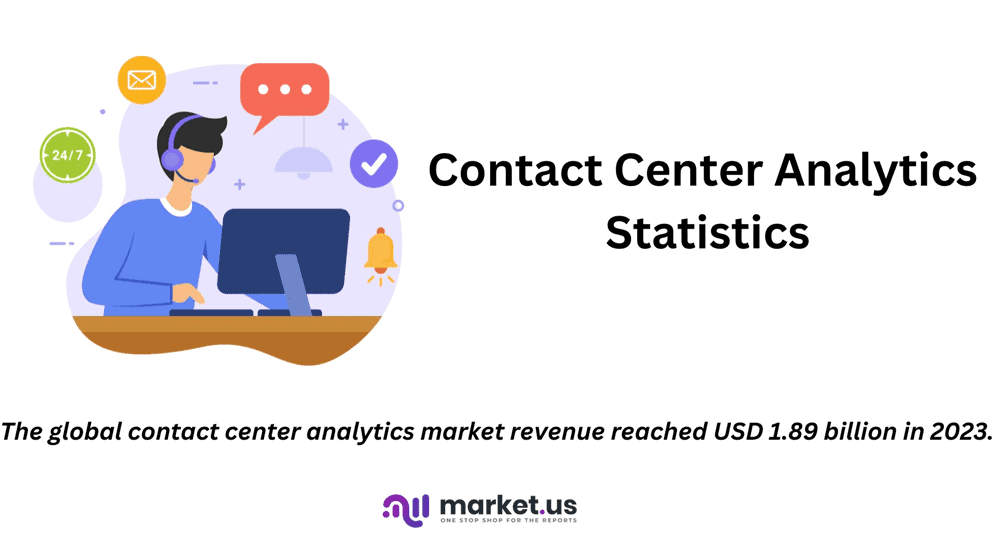
Editor’s Choice
- The global contact center analytics market revenue reached USD 1.89 billion in 2023.
- By 2033, the global contact center analytics market is expected to achieve a total value of USD 9.71 billion. With on-premise solutions comprising USD 5.44 billion and hosted solutions USD 4.27 billion.
- In 2021, the global contact center analytics market was divided by enterprise size. With large enterprises holding 58% of the market share. While small and medium-sized enterprises (SMEs) contributed the remainder.
- In 2021, the global contact center analytics market exhibited a regional distribution led by North America, which held the largest share at 32.0%.
- In 2021, the global contact center analytics market featured several key players, with Genesys leading at an 18% market share.
- In 2024, global contact centers are projected to increase AI adoption over the next two years. With 80% of respondents planning to implement process automation to streamline workflows and boost efficiency.
- In 2015, customer experience (CX) responsibility in contact centers was shared across leadership and operational roles. With 69% of respondents identifying contact center leaders as primarily accountable.
Contact Center Analytics Market Statistics
Global Contact Center Analytics Market Size Statistics
- The global contact center analytics market is projected to experience significant growth from 2021 through 2033 at a CAGR of 17.8%.
- In 2021, the market size was estimated at USD 1.36 billion.
- This figure is expected to increase steadily each year. Reaching USD 1.60 billion in 2022 and USD 1.89 billion in 2023.
- By 2024, the market size is anticipated to expand further to USD 2.22 billion.
- This upward trend is projected to continue, with the market size estimated to grow to USD 2.62 billion in 2025, USD 3.09 billion in 2026, and USD 3.63 billion in 2027.
- Moving forward, the market is forecasted to reach USD 4.28 billion by 2028 and USD 5.04 billion by 2029.
- The growth trajectory is expected to accelerate in the 2030s. With projections indicating a market size of USD 5.94 billion by 2030, USD 7.00 billion by 2031, and USD 8.24 billion by 2032.
- By 2033, the global contact center analytics market is expected to attain a substantial size of USD 9.71 billion.
- This consistent growth reflects an increasing demand for analytics solutions within contact centers. Driven by a need for enhanced customer experience management and operational efficiency.
(Source: market.us)
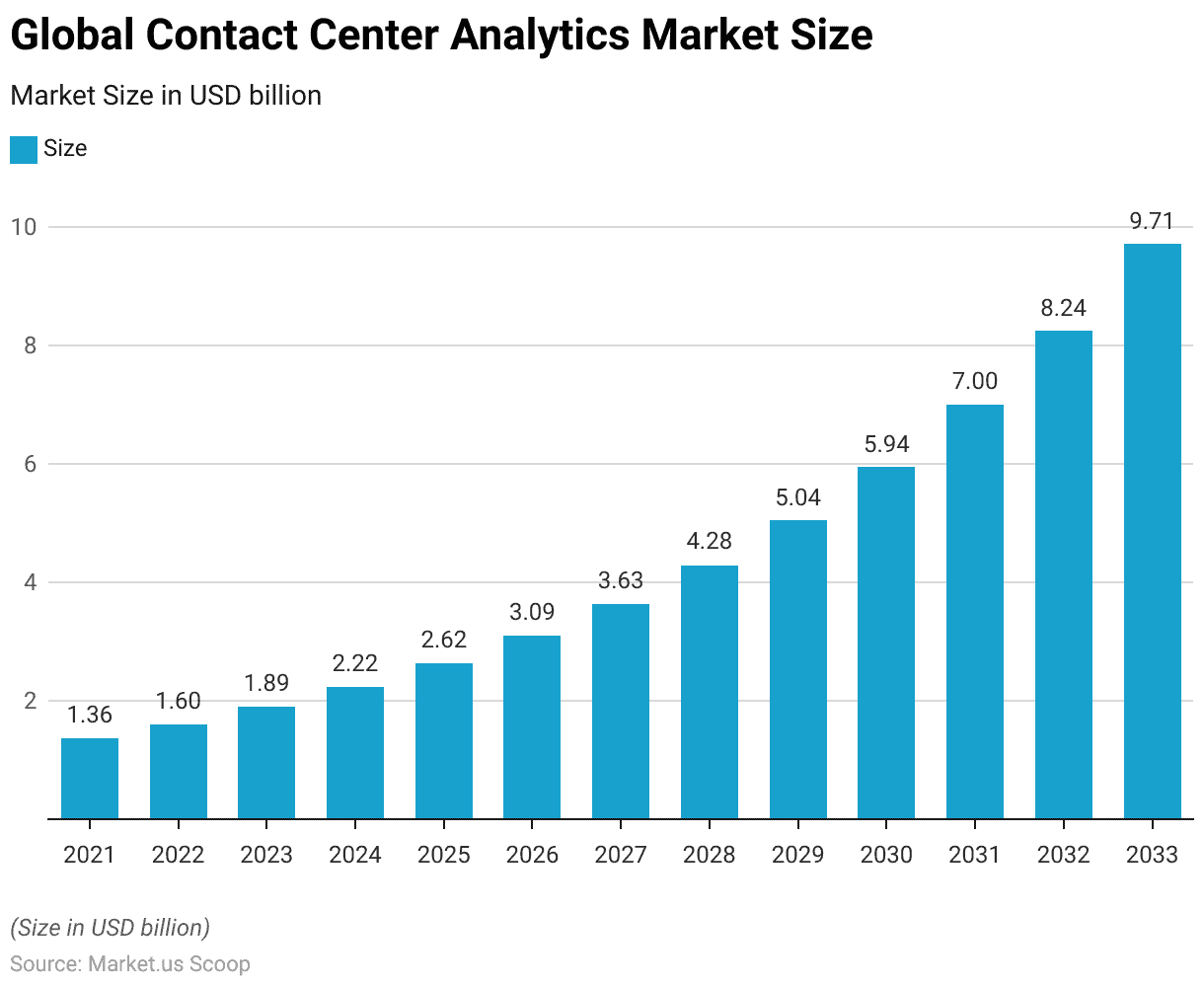
Global Contact Center Analytics Market Size – By Deployment Statistics
2021-2026
- The global contact center analytics market, segmented by deployment type into on-premise and hosted solutions, is projected to grow substantially from 2021 to 2026.
- In 2021, the overall market size was valued at USD 1.36 billion. With on-premise solutions accounting for USD 0.76 billion and hosted solutions contributing USD 0.60 billion.
- By 2022, the total market size will reach USD 1.60 billion. With on-premise and hosted deployments valued at USD 0.90 billion and USD 0.70 billion, respectively.
- This growth trajectory continued in 2023, with the market expanding to USD 1.89 billion. Where on-premise solutions comprised USD 1.06 billion and hosted solutions USD 0.83 billion.
- In 2024, the market size grew to USD 2.22 billion, with on-premise at USD 1.24 billion and hosted solutions at USD 0.98 billion.
- By 2025, the market size will reach USD 2.62 billion. Split into USD 1.47 billion for on-premise and USD 1.15 billion for hosted deployments.
- In 2026, the total market expanded further to USD 3.09 billion. With on-premise and hosted solutions valued at USD 1.73 billion and USD 1.36 billion, respectively.
2027-2033
- This upward trend persisted through 2027 when the market size reached USD 3.63 billion. Comprising USD 2.03 billion for on-premise and USD 1.60 billion for hosted solutions.
- In subsequent years, this growth pattern is expected to continue. By 2028, the market is projected to grow to USD 4.28 billion. With on-premise solutions at USD 2.40 billion and hosted solutions at USD 1.88 billion.
- In 2029, the market is anticipated to reach USD 5.04 billion. With on-premise solutions representing USD 2.82 billion and hosted solutions USD 2.22 billion.
- By 2030, the market size is expected to increase to USD 5.94 billion. With on-premise and hosted deployments at USD 3.33 billion and USD 2.61 billion, respectively.
- Looking further into the future, the total market is projected to reach USD 7.00 billion by 2031. With USD 3.92 billion for on-premise and USD 3.08 billion for hosted solutions.
- In 2032, the market is anticipated to grow to USD 8.24 billion. With on-premise solutions valued at USD 4.61 billion and hosted solutions at USD 3.63 billion.
- By 2033, the global contact center analytics market is expected to achieve a total value of USD 9.71 billion. With on-premise solutions comprising USD 5.44 billion and hosted solutions USD 4.27 billion.
- This consistent growth highlights the increasing demand for both deployment types. Driven by a focus on enhancing customer experience and operational efficiency in contact centers globally.
(Source: market.us)
Take advantage of our unbeatable offer - buy now!

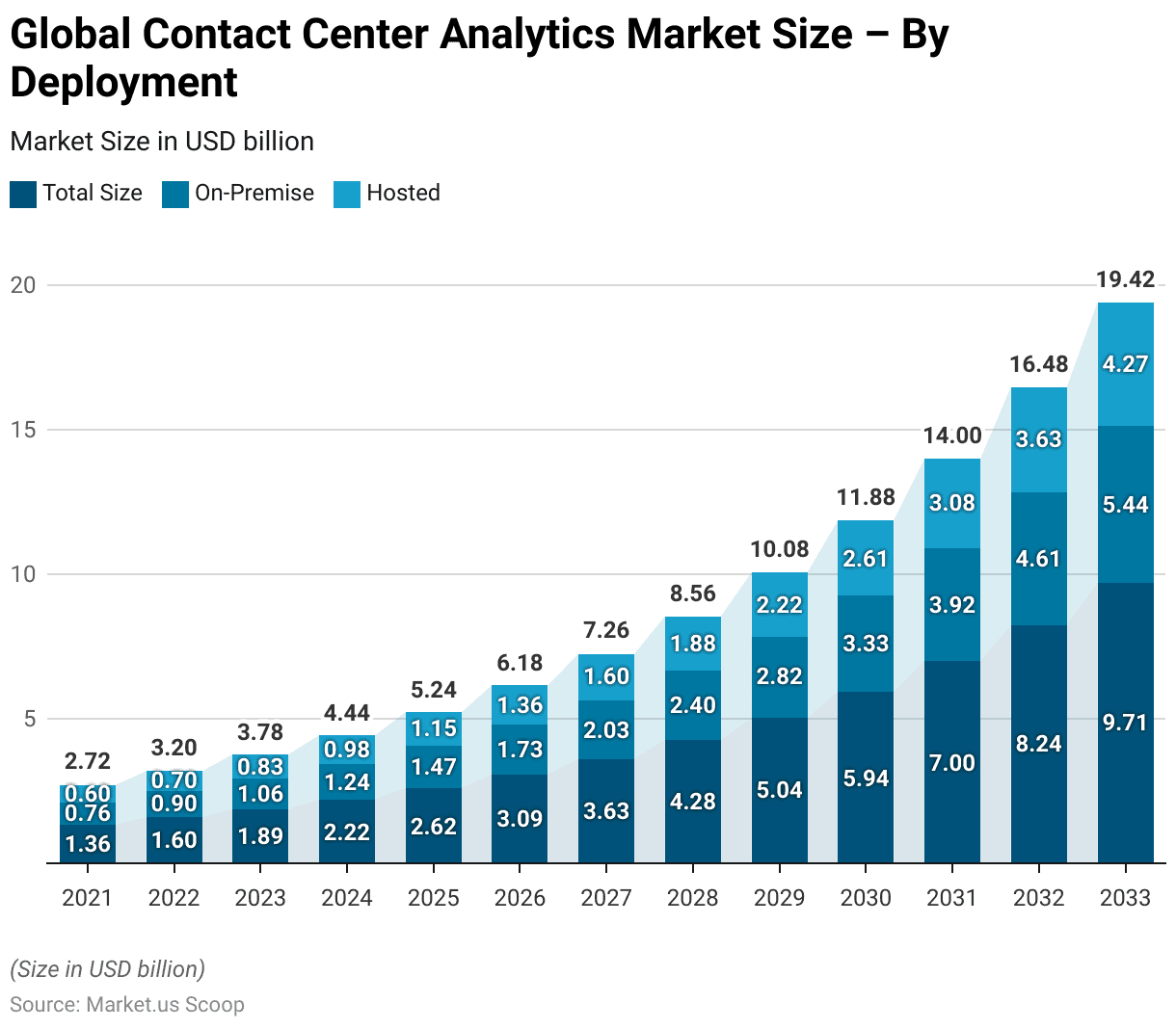
Global Contact Center Analytics Market Share – By Enterprise Size Statistics
- In 2021, the global contact center analytics market was segmented by enterprise size. With large enterprises and small and medium-sized enterprises (SMEs) contributing distinct shares.
- Large enterprises accounted for a significant portion of the market. Representing 58% of the overall market share.
- SMEs held a smaller yet substantial share, contributing 42% to the total market.
- This distribution indicates a strong demand for contact center analytics solutions across both large organizations. Which leverage analytics to optimize large-scale customer interactions and SMEs. Which increasingly adopt these solutions to enhance customer service efficiency and competitiveness in the market.
(Source: market.us)
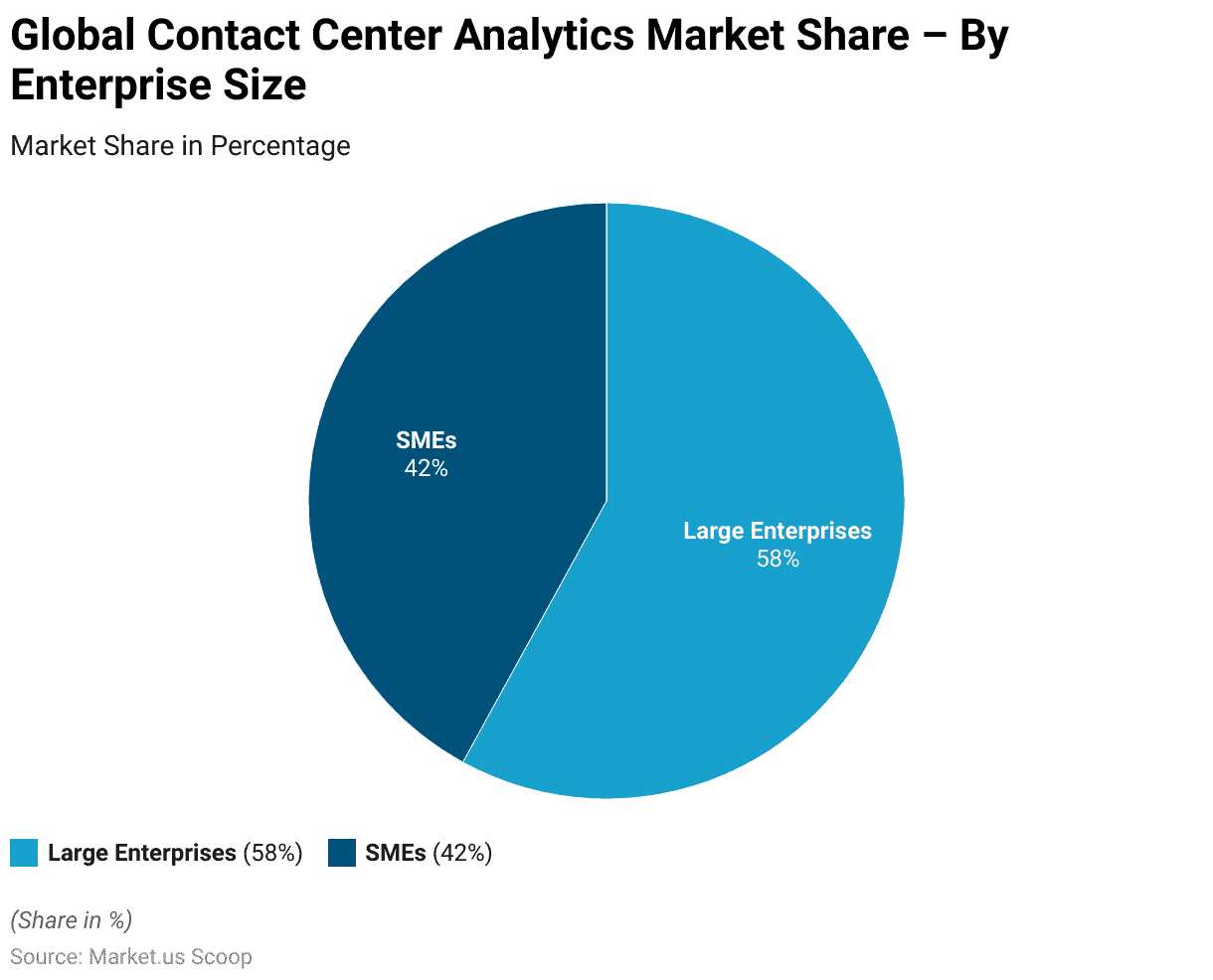
Competitive Landscape of Global Contact Center Analytics Market Statistics
- In 2021, the competitive landscape of the global contact center analytics market was characterized by the presence of several key players, each holding a varying share of the market.
- Genesys led with an 18% market share, closely followed by Oracle Corporation with 17%.
- CallMiner held a notable 12% share, while Genpact Limited accounted for 10% of the market.
- Companies such as Nice Ltd. and 8×8, Inc. each held a 9% share. Demonstrating their competitive positioning in the analytics space.
- Mitel Networks Corporation and SAP had slightly smaller shares. Representing 8% and 7% of the market, respectively.
- Other key players collectively accounted for 11% of the market share.
- This diverse competitive landscape indicates that while some companies hold significant portions of the market. There remains room for various players, driven by increasing demand for analytics to enhance customer engagement and operational efficiency in contact centers worldwide.
(Source: market.us)
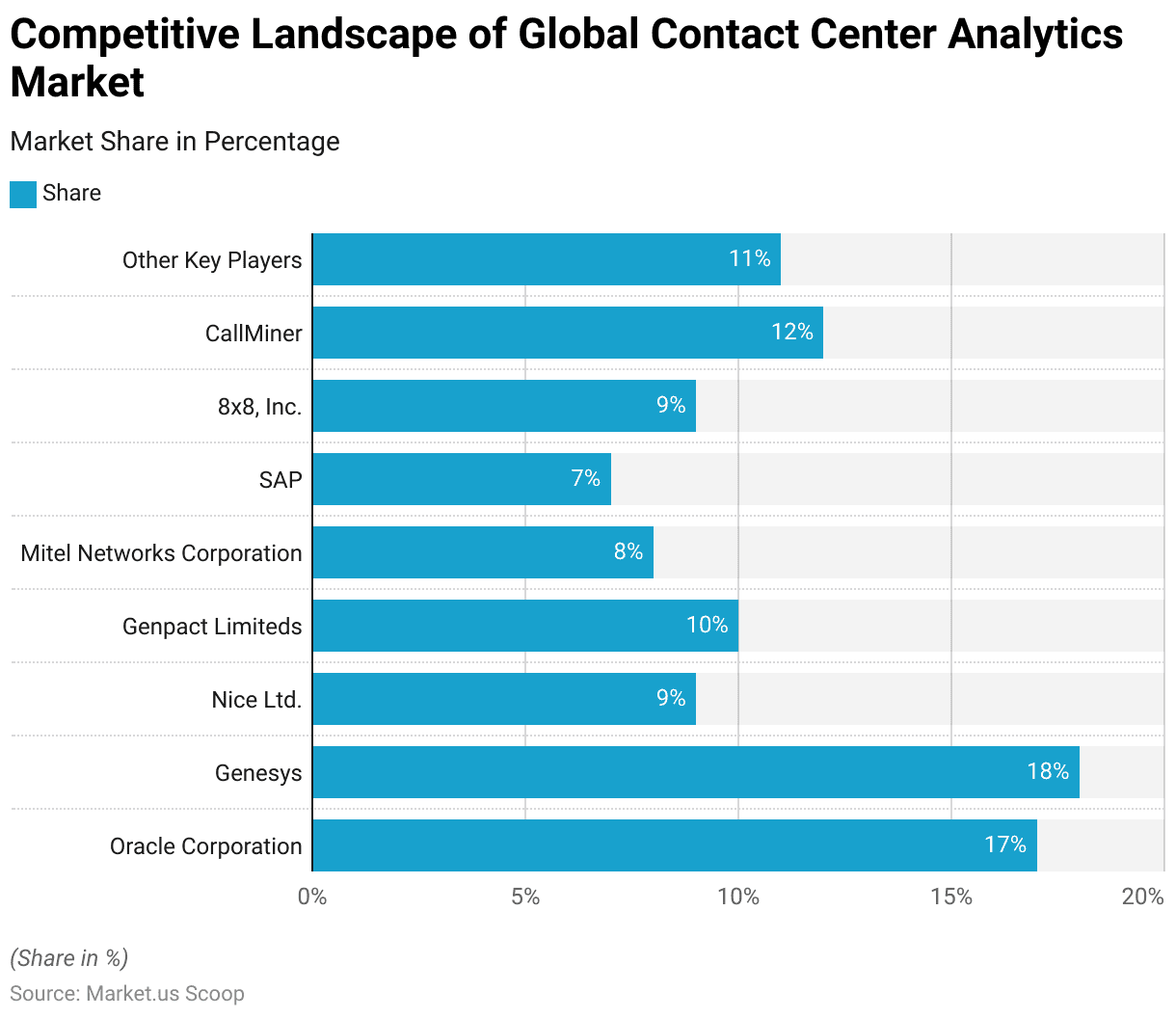
Global Contact Center Analytics Market Share – By Region Statistics
- In 2021, the global contact center analytics market exhibited a regional distribution led by North America, which held the largest share at 32.0%.
- Europe followed with a substantial 28.0% share. Reflecting strong adoption of analytics solutions in these regions.
- The Asia-Pacific (APAC) region accounted for 25.0% of the market. Underscoring the growing demand for contact center analytics in developing and technologically advancing economies within this area.
- South America represented 11.0% of the market, while the Middle East and Africa (MEA) held a smaller share at 4.0%.
- This distribution indicates a concentration of market activity in North America and Europe, with increasing potential for growth in APAC, South America, and MEA as companies in these regions enhance their focus on customer experience and operational optimization.
(Source: market.us)
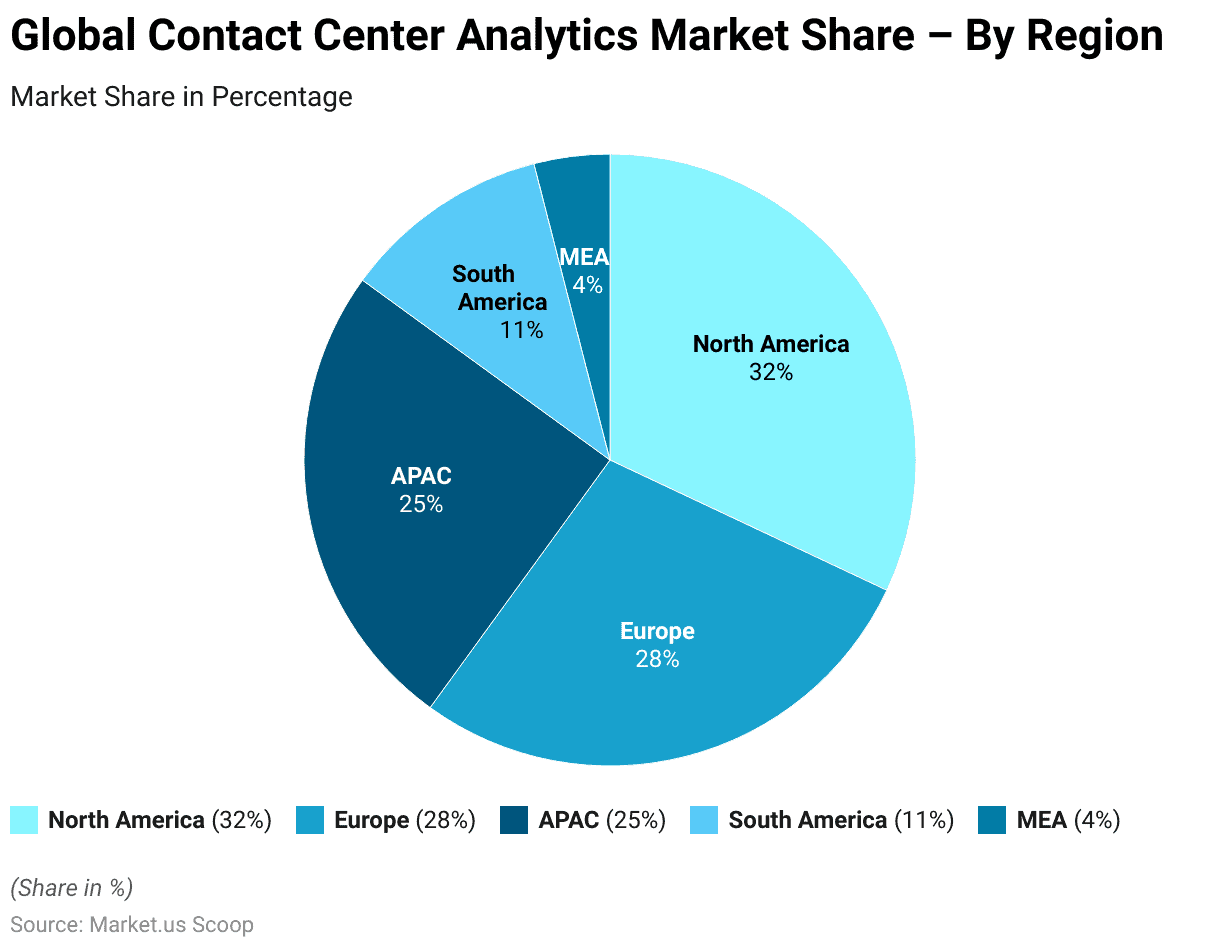
Primary Industries of Contact Centers Worldwide
- In 2021, contact centers worldwide served a variety of primary industries, each with varying levels of market representation.
- The financial services sector had the largest share of respondents, accounting for 17%. Highlighting its significant reliance on contact centers for customer interaction and service management.
- The technology, media, and telecommunications industries followed closely. Representing 15% of respondents, driven by the need for support in increasingly digital and connected services.
- The retail industry, with a share of 13%, also demonstrated a strong presence in contact center usage. Likely influenced by growing e-commerce and customer support requirements.
- Manufacturing accounted for 10% of contact center usage. Reflecting its focus on customer and supplier communication.
- The tourism and transportation sector contributed 8%. Customer inquiries and travel-related services drive demand in this industry.
- Lastly, the energy, resources, and industrial sectors comprised 7% of contact center users. Indicating a need for customer support and operational communication in a sector traditionally driven by large-scale projects and service delivery.
- This distribution highlights the diverse role of contact centers across multiple sectors. Adapting to each industry’s unique customer service needs.
(Source: Statista)
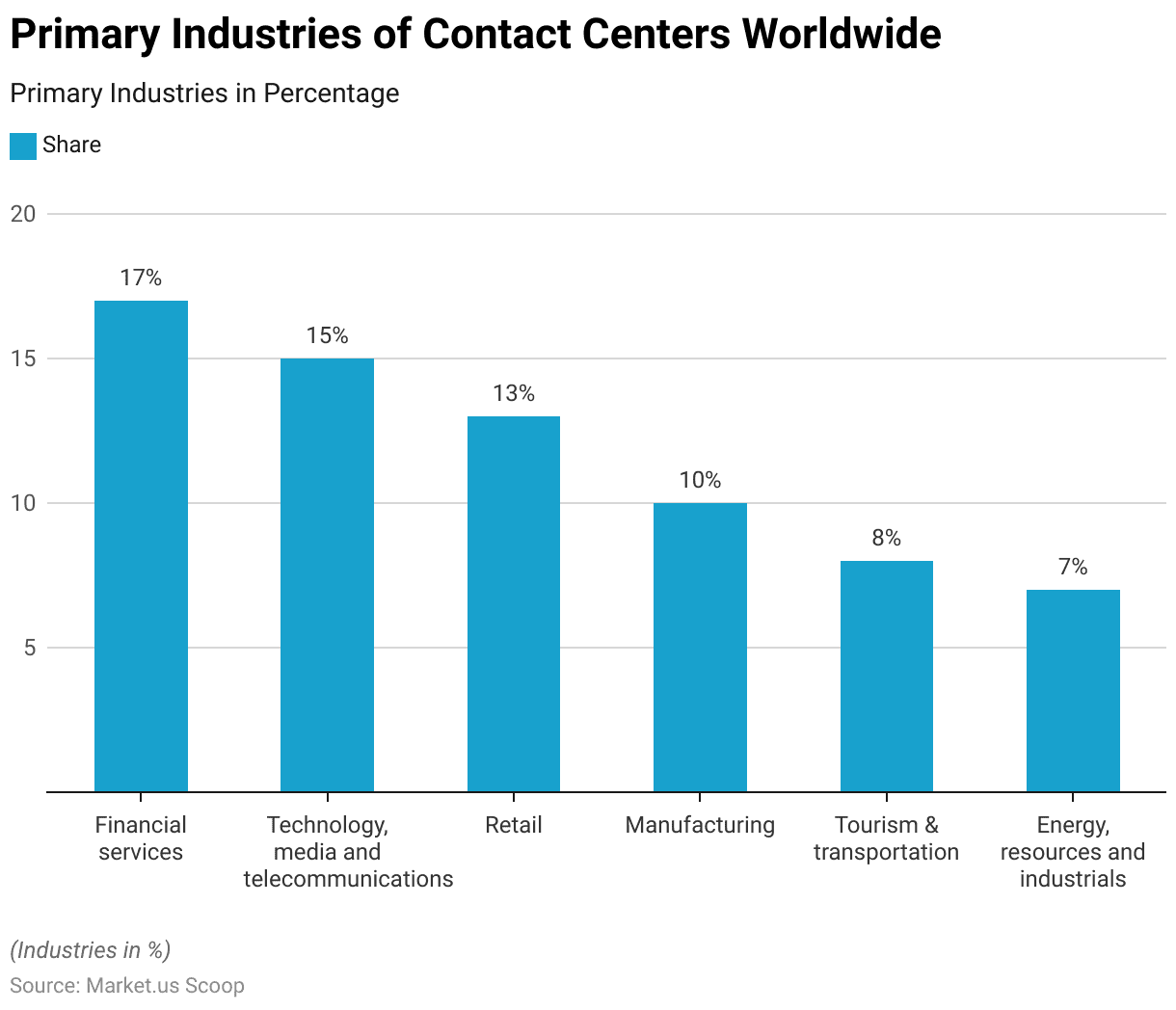
Geographical Distribution of Contact Centers Worldwide
- As of December 2016, the geographical distribution of contact centers worldwide showed a strong concentration in the Americas. This accounted for 66% of respondents, reflecting the region’s extensive use of customer service centers to support its large consumer base.
- Europe followed with a 24% share, indicating a substantial presence of contact centers. Likely driven by high customer service standards across various industries in the region.
- Additionally, 6% of the respondents did not report their specific geographical location.
- In Oceania, contact centers represented 2% of respondents, while Asia and Africa each accounted for 1% of the global distribution.
- This distribution reveals that, as of 2016, contact centers were predominantly located in the Americas and Europe, with limited presence in other regions, possibly due to varying levels of market maturity, economic development, and demand for customer support services across these areas.
(Source: Statista)
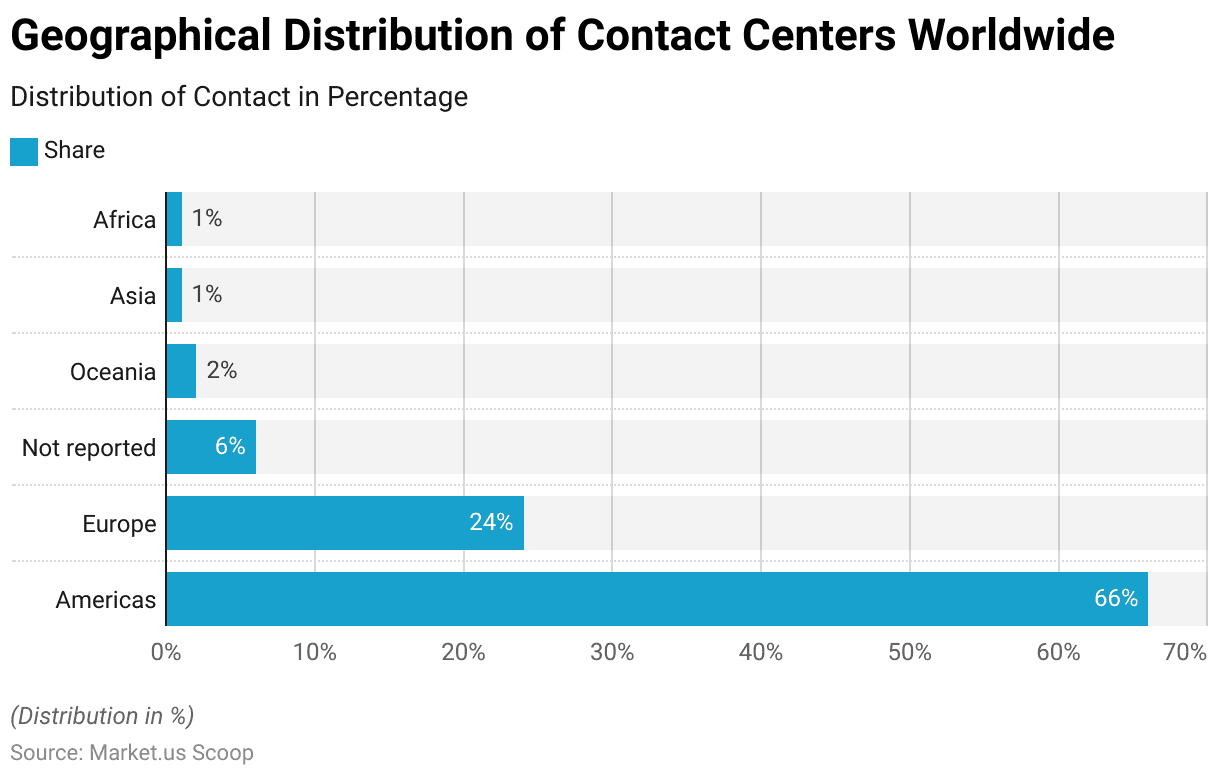
Contact Center Analytics Applications Statistics
Current Uses of Analytics Applications at Contact Center Worldwide Statistics
- In 2024, contact centers worldwide employed a range of analytics applications to enhance various operational and customer engagement functions.
- Marketing analytics was the most widely used, with 52% of respondents indicating its application. Underscoring the importance of targeted marketing efforts driven by data insights.
- Sales analytics are followed closely and utilized by 48% of respondents to optimize sales strategies and improve conversion rates.
- Social media analytics was reported by 47% of respondents. Reflecting the increasing need to monitor and engage with customers across social platforms.
- Customer behavior analytics was used by 46% of respondents. Providing insights into customer preferences and patterns to align services with expectations better.
- Speech analytics, deployed by 44% of contact centers. Facilitated real-time analysis of customer interactions to improve service quality.
- Both voice of the employee and customer journey analytics were applied by 43% of respondents. Highlighting a focus on understanding both employee satisfaction and the overall customer experience.
- Lastly, sentiment analytics was utilized by 40% of contact centers. Helping organizations gauge customer emotions and feedback to enhance service and address potential issues proactively.
- These diverse applications of analytics reflect the critical role of data-driven insights in refining customer service, sales, and engagement strategies within the contact center industry.
(Source: Statista)
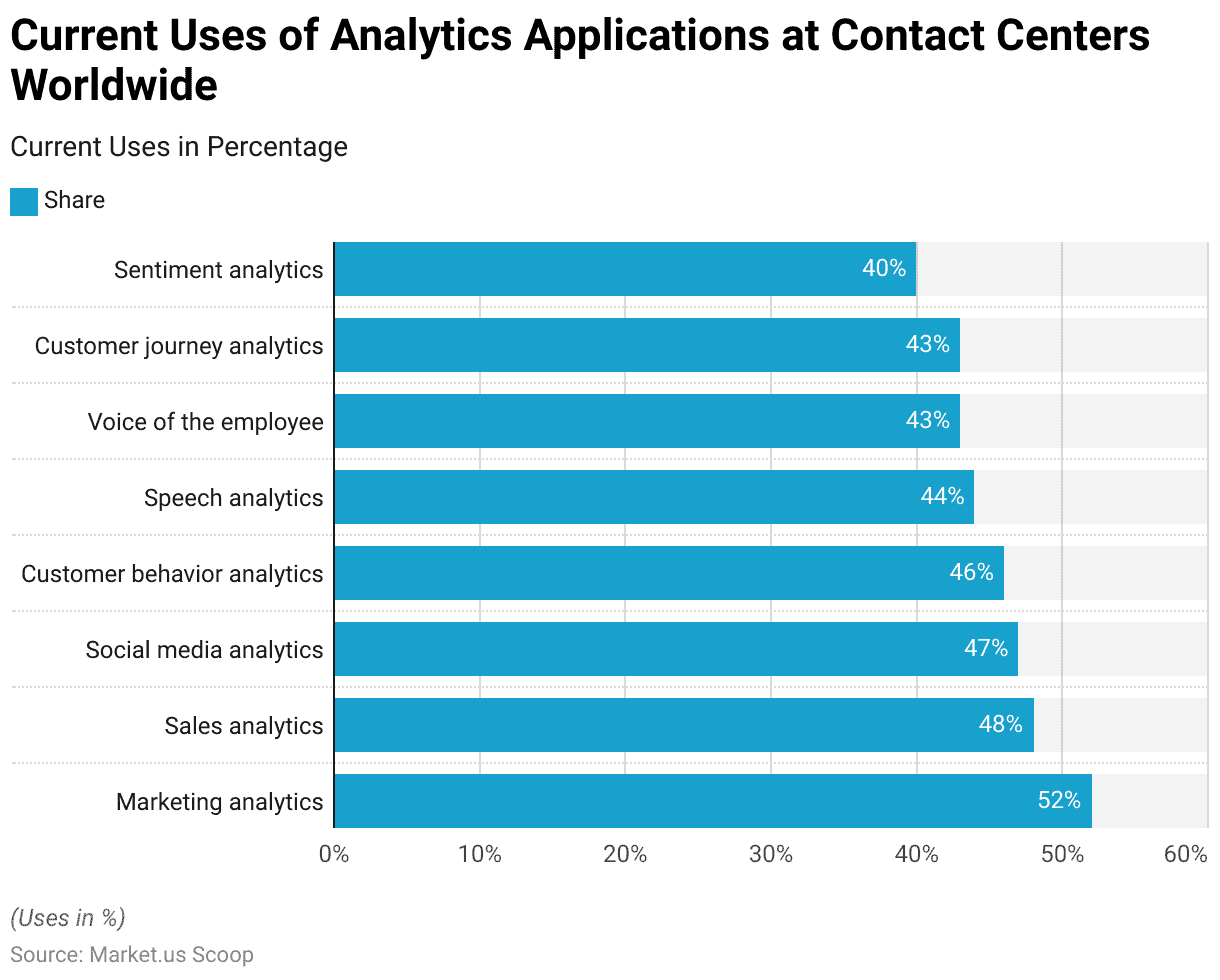
Future Uses of Analytics Applications at Contact Center Worldwide Statistics
- In 2024, projections for the next two years indicate a substantial increase in the adoption of analytics applications within contact centers worldwide.
- Marketing analytics, sales analytics, social media analytics, and customer behavior analytics are anticipated to be widely implemented. Each was cited by 87% of respondents as a critical area of focus.
- This high adoption rate highlights the importance of these analytics types in driving customer engagement, targeted marketing, and data-driven sales strategies.
- Customer journey analytics is expected to be utilized by 86% of contact centers. Reflecting a strong commitment to understanding and optimizing the customer experience across various touchpoints.
- The voice of the employee is also a priority, with 85% of respondents planning to leverage analytics to enhance employee satisfaction and performance. Which in turn can positively impact customer service quality.
- Speech analytics and sentiment analytics, are both projected to be used by 84% of respondents. Will play essential roles in real-time customer interaction analysis, helping contact centers assess customer sentiment, improve communication, and resolve issues more effectively.
- This widespread anticipated adoption across various analytics applications underscores the critical role of advanced analytics in transforming contact center operations. Enhancing both customer and employee experiences, and supporting strategic decision-making.
(Source: Statista)

Use of Artificial Intelligence (AI) at Contact Centers Worldwide
Current Uses of Analytics Applications at Contact Center Worldwide Statistics
- In 2024, artificial intelligence (AI) applications have become increasingly integrated into contact center operations worldwide, with various uses reported by respondents.
- Voice authentication and process automation are among the most widely implemented AI applications, each utilized by 37% of respondents. Underscoring the importance of security and efficiency in contact center interactions.
- Speech analytics, computer vision (image recognition), and language translation each hold a notable presence, with 36% of respondents indicating their use. Reflecting advancements in real-time customer interaction analysis and support for multilingual communication.
- Conversational AI and transcription services are used by 34% of contact centers. Highlighting the role of AI in facilitating automated customer interactions and efficient data capture.
- Emotion recognition/detection, sentiment analytics, and agent assist tools are employed by 33% of respondents. Indicating a focus on understanding customer emotions and improving agent performance.
- These applications reflect the growing reliance on AI technologies within contact centers to enhance security, streamline processes, and enrich customer and agent interactions through advanced analytics and automation capabilities.
(Source: Statista)
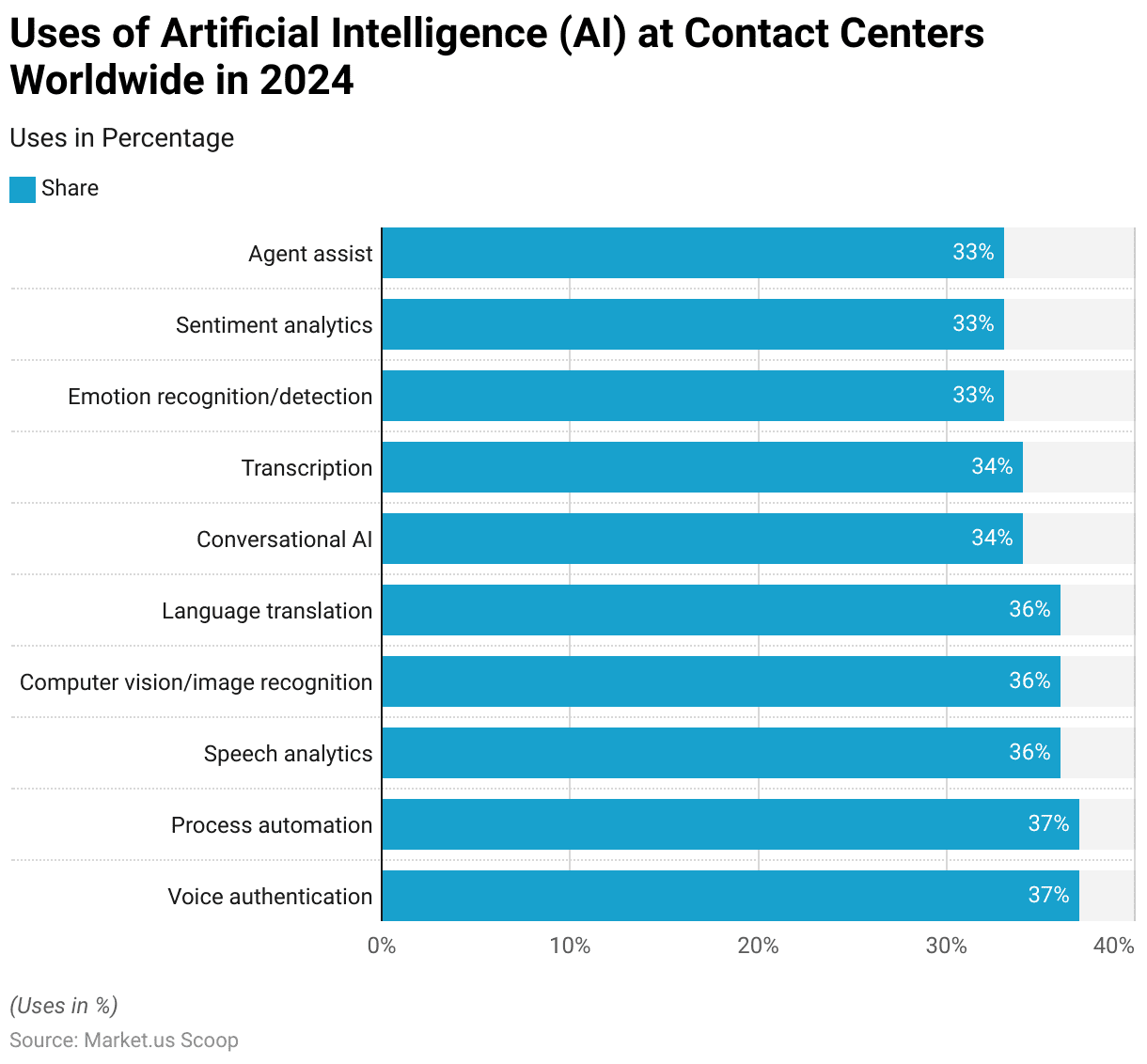
Future Uses of Analytics Applications at Contact Center Worldwide Statistics
- In 2024, projections for the next two years indicate a significant increase in the adoption of artificial intelligence (AI) technologies within contact centers worldwide.
- Process automation is anticipated to be the most widely adopted, with 80% of respondents indicating plans to implement it. Highlighting its importance in streamlining workflows and improving efficiency.
- Voice authentication and speech analytics are each expected to be utilized by 79% of contact centers. Reflecting a strong emphasis on security and real-time analysis of customer interactions.
- Conversational AI is projected to be widely adopted, with 78% of respondents indicating its use. Showcasing its potential to facilitate automated, human-like interactions with customers.
- Moreover, computer vision (image recognition) and language translation are each expected to be used by 77% of contact centers. Enabling enhanced visual data processing and support for multilingual communication.
- Transcription services are projected to be adopted by 76% of respondents, enabling efficient recording and analysis of conversations.
- Further, emotion recognition and sentiment analytics are expected to be used by 75% and 74% of contact centers, respectively. Underscoring the importance of understanding customer emotions and feedback for improved service.
- Finally, agent-assist tools are projected to be implemented by 74% of respondents. Demonstrating a focus on enhancing agent performance and support through AI-driven insights.
- These projections indicate a robust commitment to AI integration within contact centers. Aiming to enhance both operational efficiency and customer experience through advanced automation and analytical capabilities.
(Source: Statista)
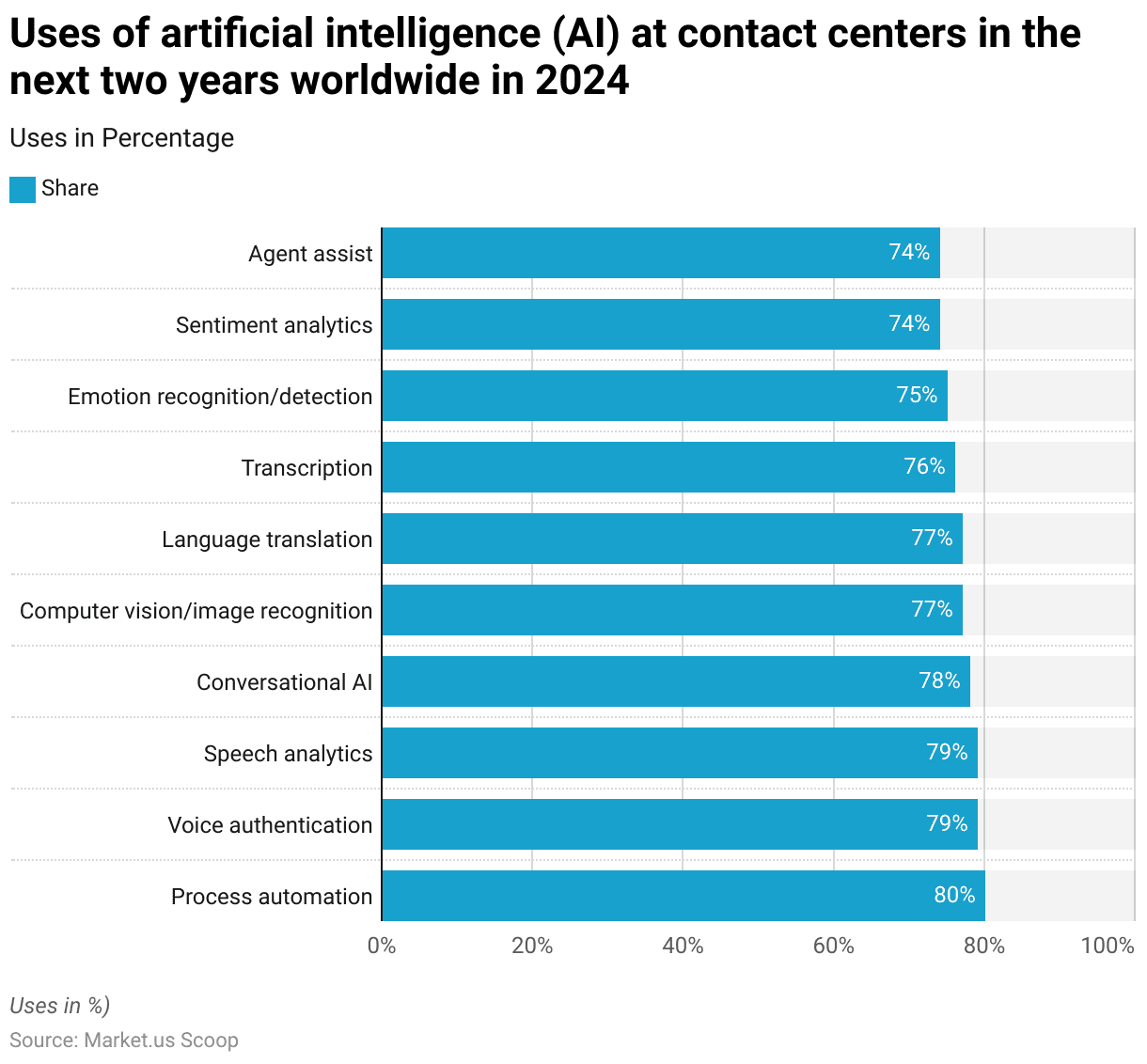
Potential Artificial Intelligence (AI) Generated Improvements at Contact Centers
- In 2024, potential improvements generated by artificial intelligence (AI) in contact centers are anticipated to deliver significant enhancements in various operational areas, as indicated by respondent projections.
- A vast majority, 81.45%, expect AI to enable more predictive and relevant services or communication. In comparison, 81.3% foresee an increase in self-service utilization and containment. Highlighting AI’s role in empowering customers to resolve issues independently.
- Additionally, 80.3% of respondents believe AI will optimize search and knowledge management, and 79.84% anticipate shorter handle times and more productive conversations through AI-driven insights.
- Further, 79.2% expect improved customer routing and journey orchestration. Enhancing the customer experience by directing them to the most suitable resources.
- Quality and consistency during interactions are projected to improve by 78.4% of respondents. While 76% anticipate more personalized service and communication. Indicating AI’s ability to tailor interactions based on individual customer profiles.
- Enhanced data collection and analysis for both customers and employees are expected by 74.4% of respondents. Reflecting AI’s capacity for generating valuable insights.
- Improved efficiency in non-interaction tasks, such as note-taking and call logging. It is anticipated that 72.8% and 70.97% foresee a reduction in agent ramp time and an improvement in agent expertise.
- Additionally, AI is expected to increase customer lifetime value for 60.8% of respondents. While 57.26% predict improvements in marketing and sales copy and customer engagement.
- These anticipated benefits reflect the growing influence of AI in refining contact center operations. Improving customer and agent experiences, and supporting more strategic customer relationship management.
(Source: Statista)
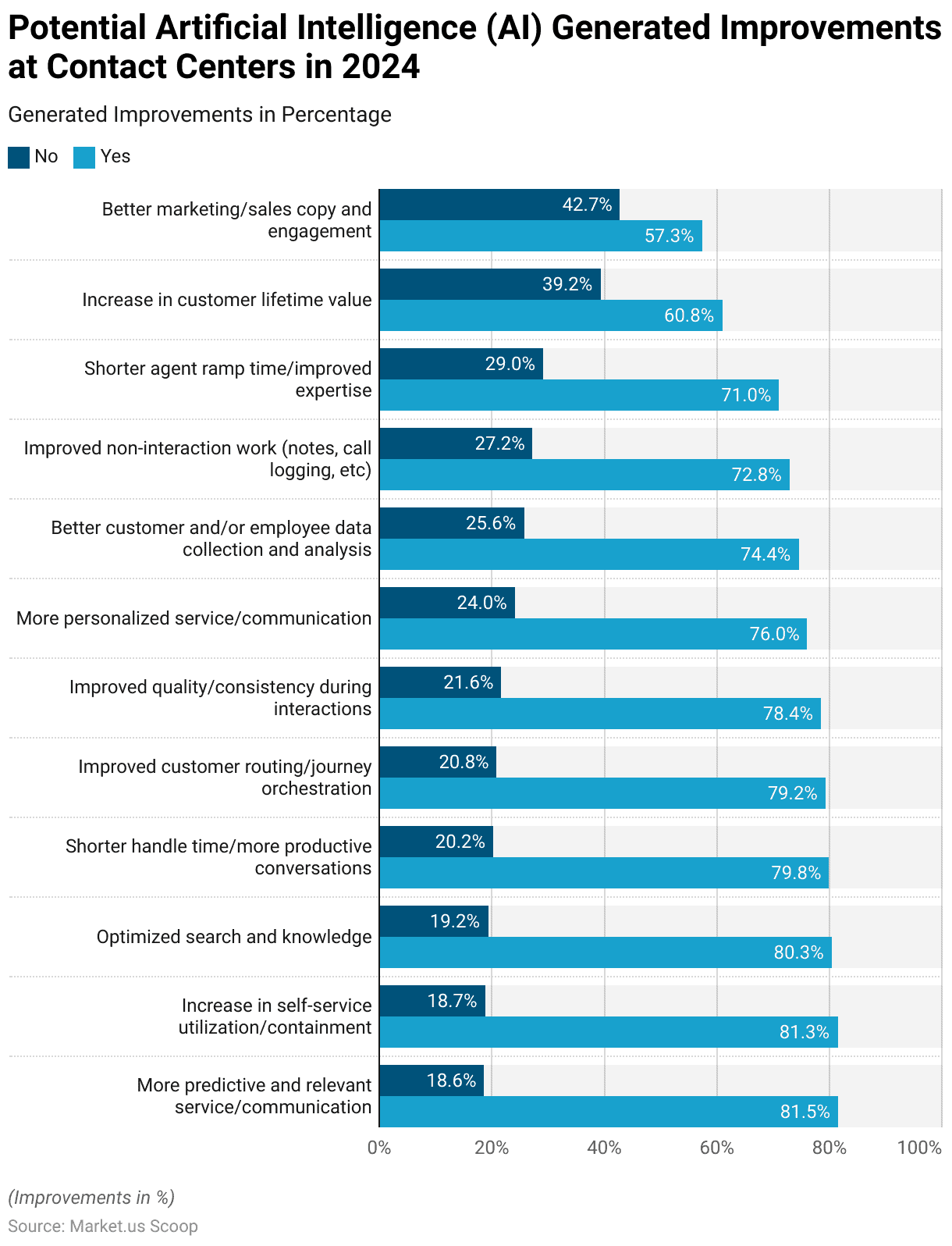
Implementation of AI for Enhancing Customer Experience
- In 2024, artificial intelligence (AI) is being widely implemented within contact centers to enhance customer experience, with various applications gaining traction among respondents.
- Half of the respondents reported using AI to analyze open feedback, enabling deeper insights into customer opinions and needs.
- Additionally, 50% of respondents are utilizing AI for content creation, supporting personalized and efficient communication with customers.
- Chatbots and other natural language processing (NLP) tools are also popular, with 48.05% of respondents implementing these technologies to facilitate real-time interactions and improve response times.
- Machine learning and predictive analytics are employed by 26.62% of respondents. Allowing contact centers to anticipate trends and proactively address customer needs.
- Predictive capabilities extend to customer behavior as well, with 21.43% of respondents using AI to forecast customer actions, enhancing personalization and engagement.
- Voice and speech recognition technologies are used by 20.78% of respondents. Further support customer interactions by enabling seamless communication through voice-based channels.
- Further, This diverse application of AI underscores its role in transforming customer service by fostering efficiency, personalization, and a deeper understanding of customer needs within contact centers.
(Source: Statista)
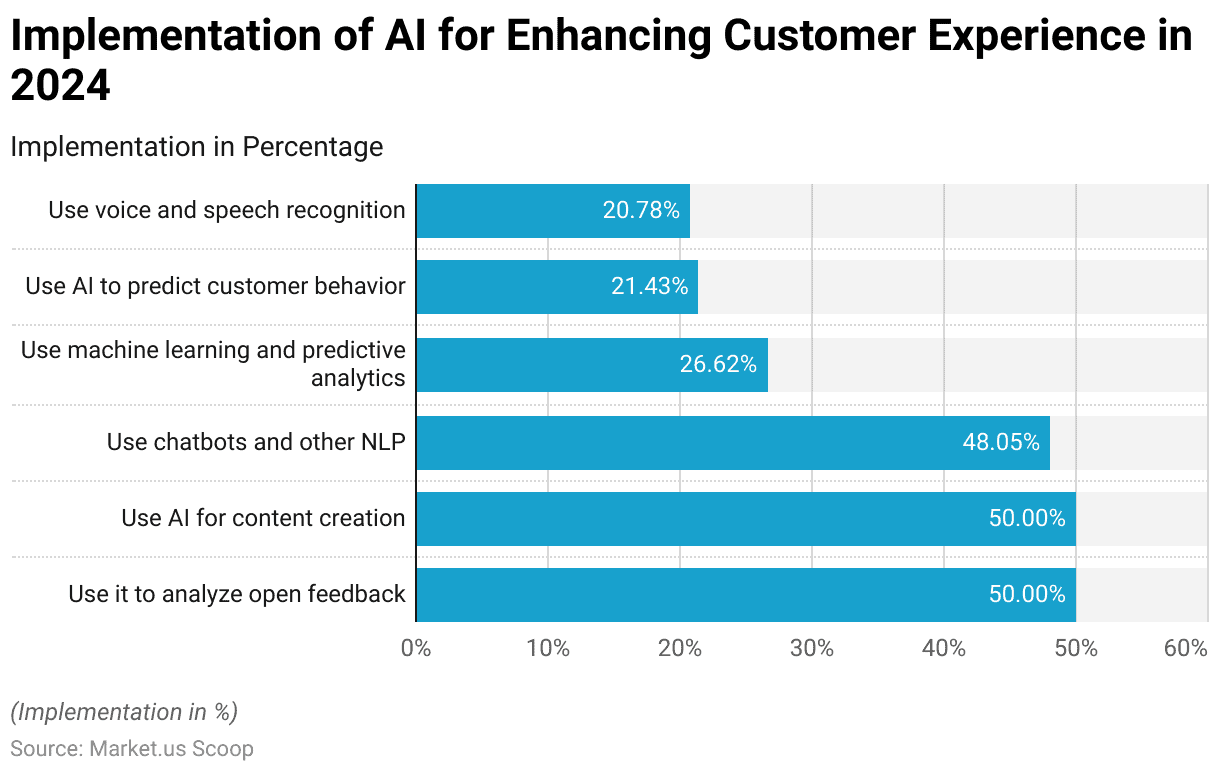
Uses of AI Workspace Monitoring at Contact Centers
- Moreover, In 2023, artificial intelligence (AI) has been increasingly applied in workspace monitoring within contact centers across North America, with notable differences in adoption rates between Canada and the United States.
- In the United States, 88% of contact centers reported using AI for recording voice interactions, compared to 79% in Canada. Online monitoring was similarly high, with 85% adoption in the U.S. and 76% in Canada.
- Tone and emotion analysis, a feature that provides insights into emotional cues during interactions, was utilized by 84% of U.S. centers and 66% of Canadian centers.
- Live monitoring, which enables real-time supervision of agent interactions, was reported by 82% of U.S. centers and 57% in Canada. Screen grabbing, another prevalent AI tool, was used by 80% of contact centers in the United States and 72% in Canada, allowing managers to capture and review screens during interactions.
- Tracking text or chat activity was conducted by 69% of U.S. centers, while 63% of Canadian centers implemented this form of monitoring. Tracking keystrokes had lower but comparable adoption rates, with 58% in the U.S. and 57% in Canada.
- Camera recording was notably less utilized, with only 23% adoption in both countries, reflecting possible concerns over privacy or limited necessity for video surveillance.
- These statistics indicate a robust reliance on AI for various monitoring functions within North American contact centers, with slightly higher adoption rates observed in the United States across most categories.
(Source: Statista)
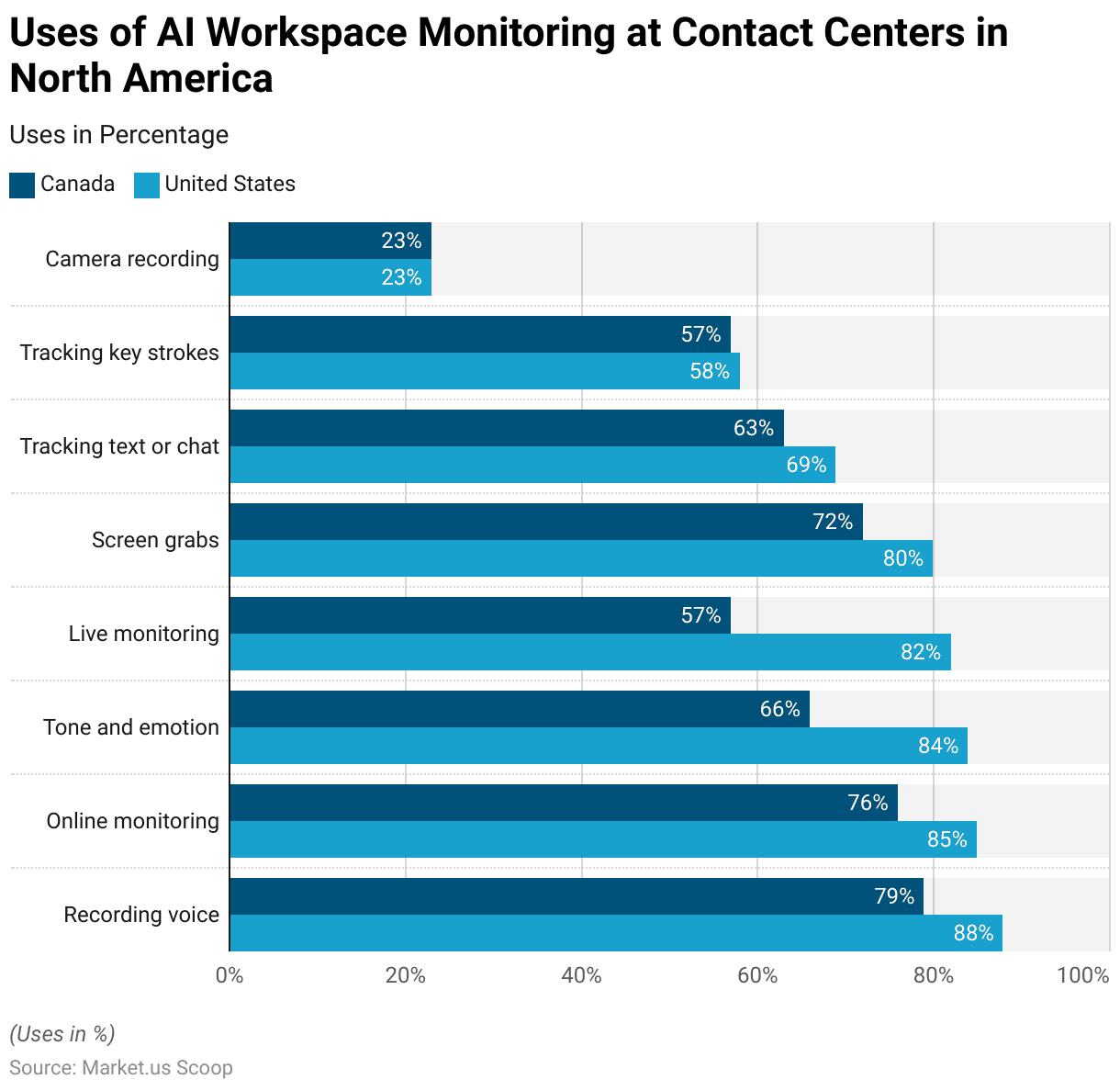
Use of Generative Artificial Intelligence (GenAI) at Contact Centers Worldwide
Generative Artificial Intelligence (GenAI) Use at Contact Centers Worldwide
- In 2024, the adoption of generative artificial intelligence (GenAI) within contact centers worldwide reveals significant future planning for its implementation.
- A considerable portion, 42% of respondents, plan to begin using GenAI in 2025, highlighting a strong interest in integrating this technology soon.
- An additional 26% intend to adopt GenAI within the current year, 2024, reflecting an immediate commitment by some organizations to leverage its capabilities.
- Looking further ahead, 17% of respondents expect to implement GenAI in 2026 or beyond, indicating that long-term adoption strategies are also in place.
- Meanwhile, 15% of contact centers are already utilizing GenAI, suggesting that a foundation of early adopters is paving the way for broader industry use.
- Further, only 1% of respondents report having no plans to implement GenAI, underscoring the widespread recognition of its potential to transform contact center operations through advanced AI-driven functionalities.
(Source: Statista)
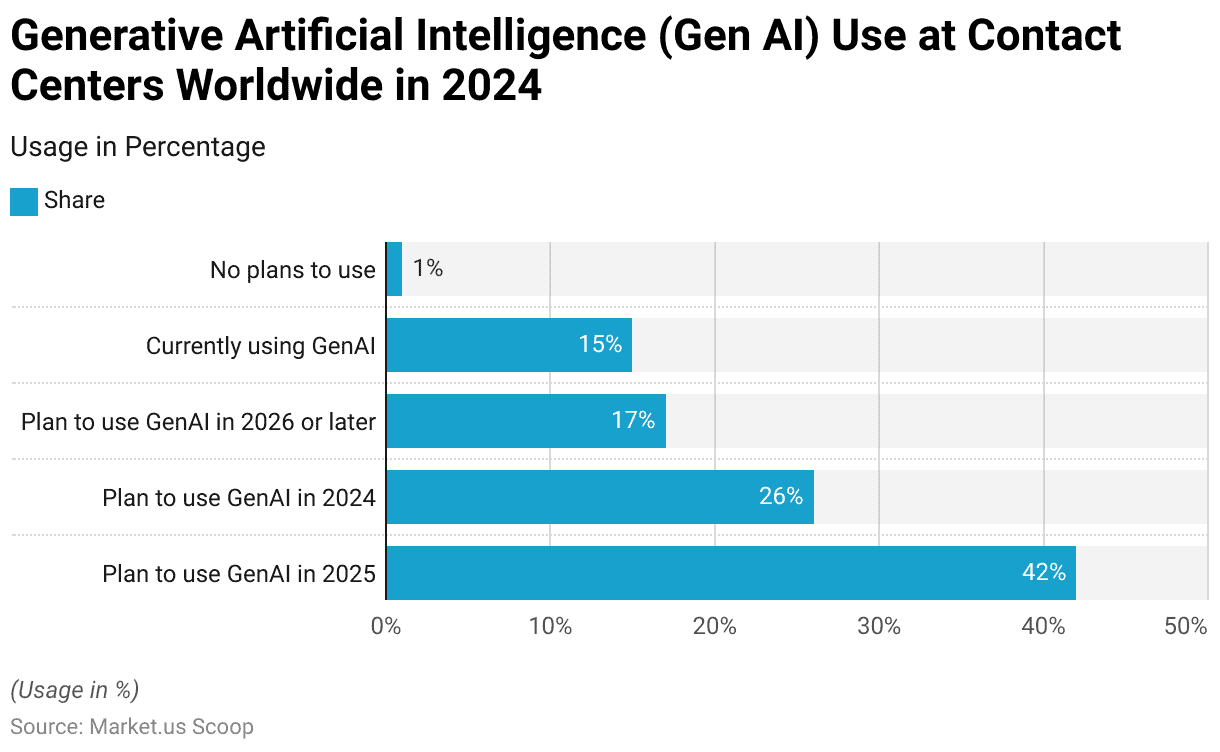
Impact of Generative Artificial Intelligence (GenAI) Use at Contact Centers Worldwide
- In 2024, the impact of generative artificial intelligence (GenAI) on contact centers worldwide is evident in several key performance areas, as reported by current users and future adopters.
- Among those currently using GenAI, 57% noted improvements in customer effort scores, reflecting GenAI’s ability to streamline customer interactions and reduce the effort required to resolve issues.
- Moreover, In terms of agent productivity, 56% of current GenAI users observed higher productivity levels, indicating that the technology effectively supports agents in managing and handling customer inquiries more efficiently.
- Additionally, 47% of current GenAI users reported improved deflection to self-service channels, suggesting that GenAI enhances self-service options, allowing customers to resolve simpler issues independently.
- Improved agent occupancy rates, which indicate better utilization of agent time, were reported by 46% of current GenAI users.
- For future adopters, anticipated impacts are similarly positive, with 35% expecting better customer effort scores, 41% forecasting higher agent productivity, 32% predicting improved self-service deflection, and 31% expecting enhanced agent occupancy rates.
- These projections highlight the potential of GenAI to enhance both customer experience and operational efficiency within contact centers as adoption increases.
(Source: Statista)
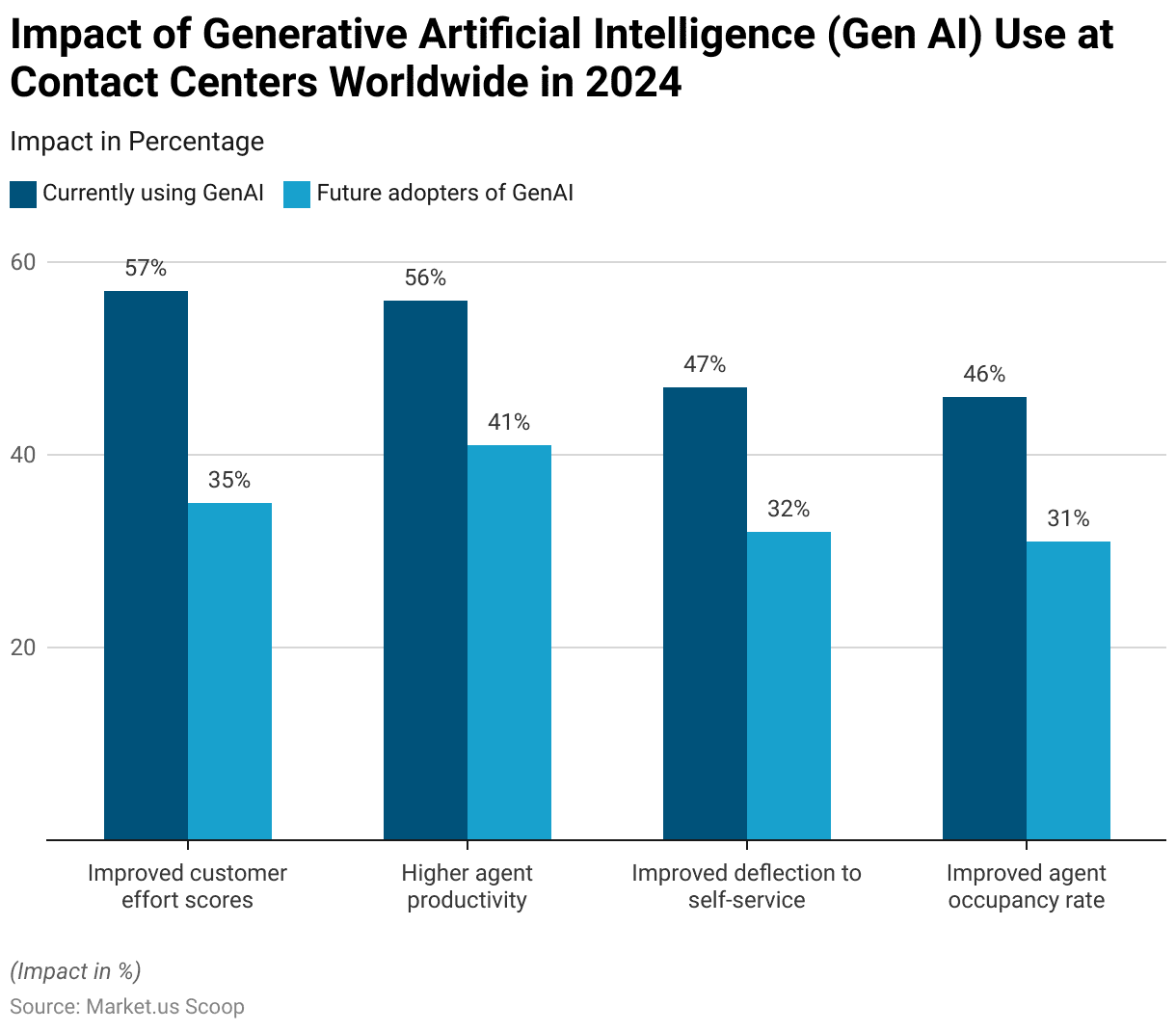
Factors Impacting the Contact Center Industry in Various Services
- In 2018, various factors were identified as significant influences on the contact center industry across different service types, including customer services (B2B and B2C), IT helpdesk support (B2B and B2C), and sales (B2B and B2C).
- Further, customer analytics emerged as the leading factor expected to reshape customer experience (CX) across all categories, with 52% in customer services B2B, 61.2% in customer services B2C, 51.1% in IT helpdesk B2B, 46.2% in IT helpdesk B2C, 64.9% in sales B2B, and 68.8% in sales B2C, highlighting its crucial role in enhancing data-driven decision-making and personalization.
- Artificial intelligence (AI) was also viewed as transformative, with notable adoption rates across service types: 42.9% for customer services B2B, 49.1% for customer services B2C, 53.2% for IT helpdesk B2B, 51.3% for IT helpdesk B2C, 44.6% for sales B2B, and 50% for sales B2C.
- Digital integration, essential for streamlining operations and improving user experience, was prioritized similarly across segments. Reaching 42.4% in customer services B2B, 45.8% in customer services B2C, 34% in IT helpdesk B2B, 48.7% in IT helpdesk B2C, 43.2% in sales B2B, and 47.9% in sales B2C.
More Insights
- Robotic process automation (RPA) also held importance, especially in IT helpdesk (B2B at 27.7% and B2C at 28.2%), with customer services B2B at 27.3% and customer services B2C at 26.2%. Service personalization was another focal area, with higher relevance in sales B2B (40.5%) and B2C (33.3%), indicating the emphasis on tailored customer interactions in sales-driven contexts.
- Further, other factors, such as proactive automation, emerging technology systems, evolving technology architectures, and re-inventing operating models, varied in impact across different service types, reflecting the diversity in priorities and operational needs within the contact center industry.
- Cybersecurity was especially noted in the IT helpdesk (19.1% for B2B), underlining the critical role of security in tech support environments. Overall, these trends illustrate a broad shift towards analytics, AI, digital integration, and automation aimed at refining CX across various segments of the contact center industry.
(Source: Statista)
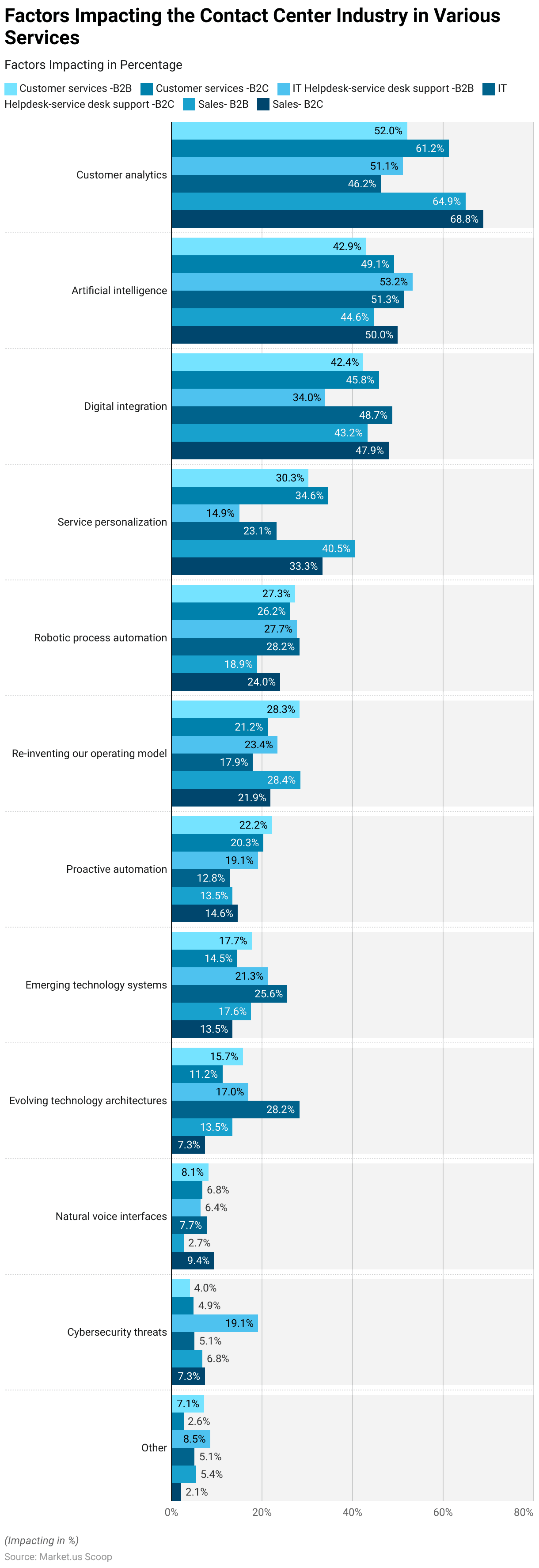
Role of Contact Center Leadership in Customer Experience
- In 2015, responsibility for customer experience (CX) within contact centers worldwide was distributed across various leadership and operational roles.
- Contact center leaders were identified as the primary accountable members, with 69% of respondents indicating their involvement in managing CX.
- Chief Experience Officers (CXOs) also played a significant role, with 61% of respondents reporting CXO accountability in CX-related outcomes, reflecting a strategic emphasis at the executive level.
- Contact center representatives, the frontline staff directly interacting with customers, were considered accountable by 35% of respondents, highlighting the importance of agent-level engagement in shaping customer perceptions.
- Additionally, 33% of respondents identified business units as accountable for customer experience, suggesting an integrated approach where multiple organizational departments contribute to enhancing CX.
- This distribution indicates a layered approach to CX accountability within contact centers, involving both leadership and operational roles to ensure a holistic focus on customer satisfaction.
(Source: Statista)
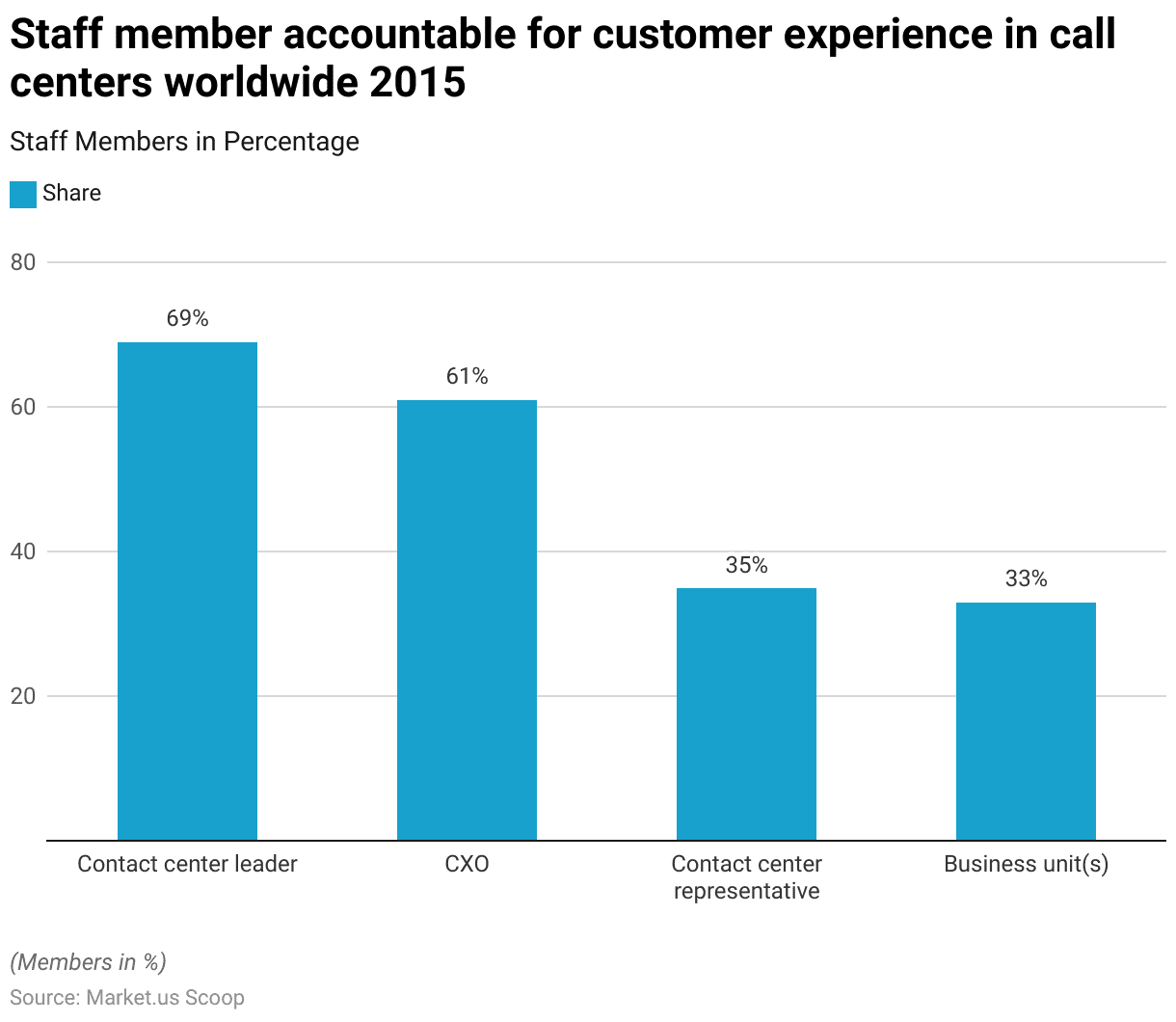
Consumer Satisfaction
Global Contact Center Satisfaction Index
2010-2014
- From 2010 to 2014, the global contact center satisfaction index, measured on a 100-point scale, reflected variations in customer satisfaction within the private and government sectors.
- In 2010, the satisfaction index stood at 75 for the private sector and 64 for the government sector, showing a notable gap between the two.
- Satisfaction in the private sector slightly increased to 76 in 2011, while the government sector saw a significant rise to 69.
- This level was maintained for the government in 2012, with the private sector index remaining stable at 75.
- In 2013, both sectors experienced improvements, with the private sector reaching its highest score in the period at 77, while the government sector increased to 72.
- However, in 2014, satisfaction in both sectors declined, with the private sector dropping to 69 and the government sector to 63.
2015-2022
- Over the next few years, from 2015 to 2018, satisfaction scores fluctuated within a narrow range, with the private sector varying between 68 and 72, while the government sector remained relatively stable, averaging around 67 to 68.
- In 2019, the private sector satisfaction index dropped further to 68, and the government sector decreased to 63.
- By 2020, the private sector rebounded to 76, while the government sector showed minimal improvement, reaching 64.
- In 2021, the private sector’s index score dropped again to 71, matching the 2016 score, while the government sector returned to 68.
- In 2022, the private sector satisfaction index decreased to 69, whereas the government sector reached a new peak of 70, suggesting an improvement in government sector customer satisfaction over time.
- This data illustrates overall fluctuations in satisfaction levels across both sectors, with the private sector generally maintaining a higher index than the government, except for the convergence observed in 2022.
(Source: Statista)
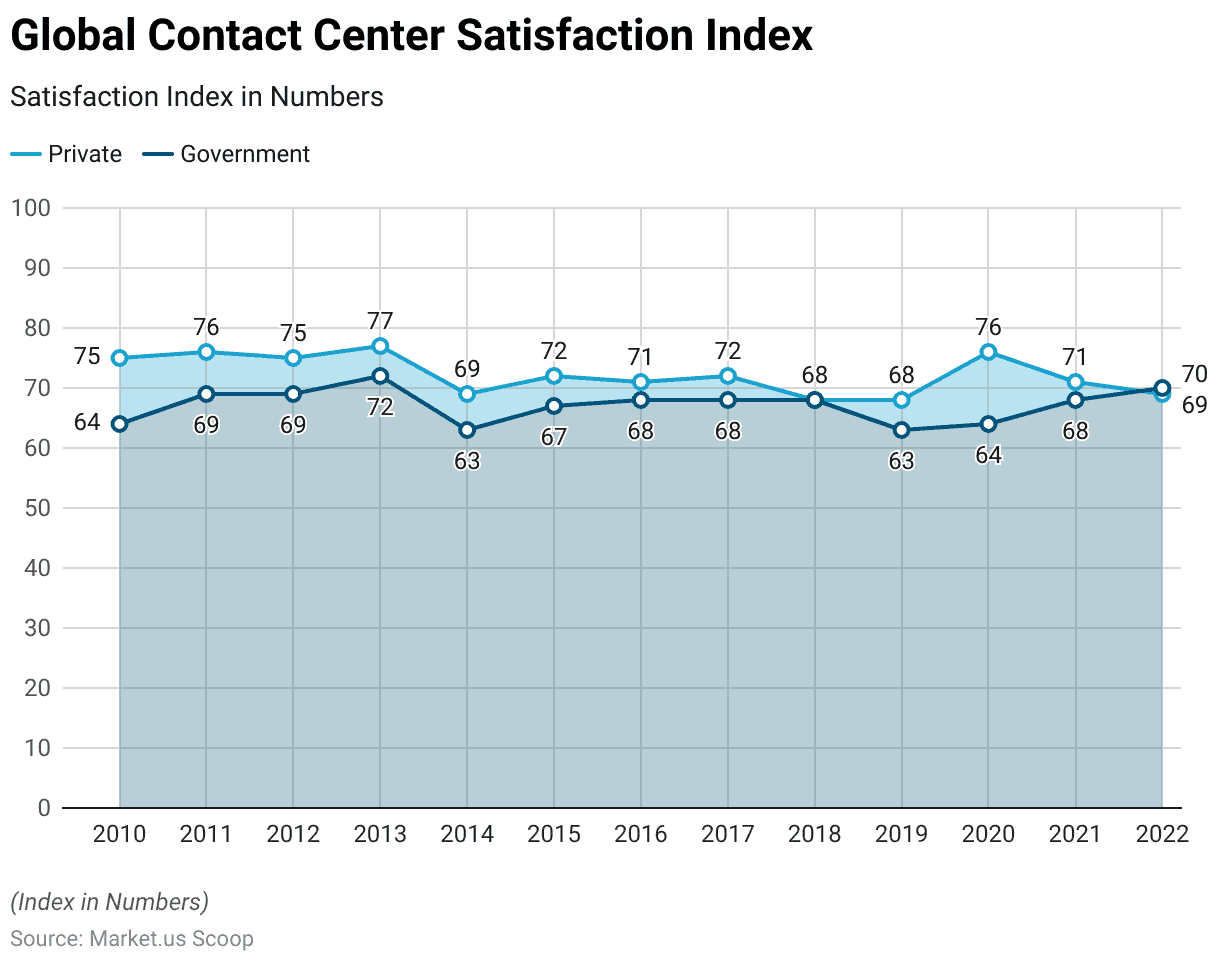
Global Contact Center Satisfaction Index – By Industry
- From 2016 to 2019, the global contact center satisfaction index, measured on a 100-point scale, varied across different industries.
- In the banking and credit union sector, satisfaction declined gradually. Starting at 75 in 2016 and falling to 72 by 2019.
- The property and casualty insurance industry experienced a rise in satisfaction. From 70 in 2016 to a peak of 76 in 2018, but then dropped back to 70 in 2019.
- The cell phone service sector showed a notable improvement over this period, with its satisfaction score increasing from 63 in 2016 to 70 by 2018, where it remained in 2019.
- Retail also demonstrated an upward trend, with satisfaction climbing from 67 in 2016 to 70 in 2018 before a slight decrease to 69 in 2019.
- Health insurance, however, saw fluctuating satisfaction levels. Starting at 67 in 2016, dipping to 64 in 2017, recovering to 69 in 2018, and then dropping again to 65 in 2019.
- In the cable or satellite TV industry, satisfaction started at 64 in 2016, fell to 61 in 2017, and then gradually rose back to 64 by 2019.
- This data reveals varied trends across industries, with some sectors showing consistent improvement while others experienced declines or fluctuations in customer satisfaction within their contact centers.
(Source: Statista)
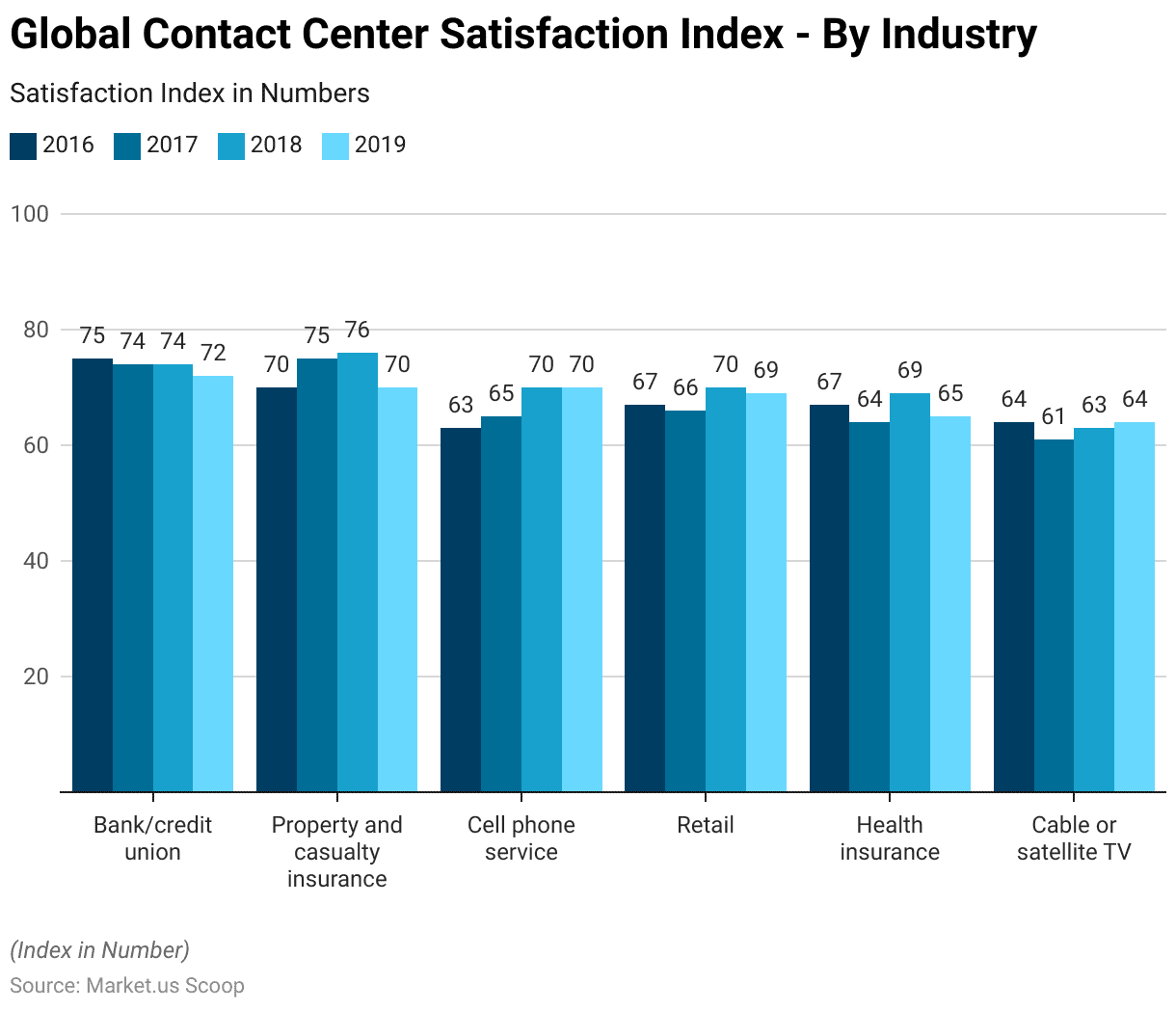
Regulations for Contact Center Analytics
- Regulations for contact center analytics vary by region and are subject to a range of legal frameworks aimed at ensuring data privacy, security, and consumer protection.
- In the European Union, the General Data Protection Regulation (GDPR) mandates stringent controls over personal data. Giving individuals the right to access and request the deletion of their data.
- The United States enforces several specific acts like the Dodd-Frank Act, which requires the recording and timestamping of phone conversations in contact centers, and the Payment Card Industry Data Security Standard (PCI-DSS). Which sets standards for the security of payment data processed in contact centers.
- Additionally, the Health Insurance Portability and Accountability Act (HIPAA) is crucial for contact centers handling health-related information. Ensuring that personal health information is strictly protected and shared only under compliant conditions.
- Globally, the adoption of contact center analytics is driven by technological advancements and the integration of AI and real-time monitoring. Which enhances operational efficiency and customer experience across various industries, including banking, healthcare, and government.
- Market trends indicate a significant growth trajectory in the use of these analytics. Propelled by the increasing deployment of AI and cloud-based solutions. Facilitating advanced data analytics practices and offering multi-channel communication capabilities.
- The focus is not only on compliance with regulations but also on leveraging technology to improve service quality and customer engagement.
(Sources: Cx Today, Tethr)
Innovations and Developments in Contact Center Analytics Statistics
- The landscape of contact center analytics is rapidly transforming with the integration of advanced technologies, particularly generative AI and machine learning.
- These innovations are enhancing the capabilities of contact centers in several critical areas. Real-time data analytics, personalized customer interactions, and operational efficiency.
- Companies like Deloitte and Microsoft are at the forefront. Deploying AI models that offer real-time insights and recommendations to agents. Thus optimizing both customer care and business operations.
- Amazon has also made significant strides with its Amazon Connect platform. Incorporating generative AI to empower agents with real-time decision support and customer interaction analytics. Thereby improving the customer service experience and operational effectiveness.
- CallMiner and Genesys have been recognized for their comprehensive interaction analytics that leverage AI to provide agents. With next-best-action guidance and customer engagement insights.
- Furthermore, the adoption of cloud-based solutions and AI technologies is streamlining customer service processes and enabling a more seamless experience for both customers and agents, as noted by MyOperator.
- These advancements are not only improving the responsiveness of contact centers. Still, they are also turning them from cost centers into strategic assets that can significantly influence the bottom line of businesses.
(Sources: Deloitte United States, Microsoft, Amazon Web Services, Inc, Destination CRM, Engage India)
Recent Developments
Acquisitions and Mergers:
- Five9’s Acquisition of Aceyus: In August 2023, Five9 acquired Aceyus, a company specializing in data integration and analytics. To enhance its capabilities in optimizing customer experiences. This strategic move aims to strengthen Five9’s position in the contact center analytics market.
- SAP’s Acquisition of Askdata: In July 2022, SAP SE announced the acquisition of Askdata, a startup specializing in search-driven analytics. This acquisition enhances SAP’s ability to assist businesses in making informed decisions through AI-driven natural language searches.
New Product Launches:
- Gladia’s Multilingual Real-Time Audio Transcription and Analytics Engine: In October 2024, Gladia launched a multilingual real-time audio transcription and analytics engine. Aiming to assist contact centers in automating and streamlining processes. This product supports over 100 languages, offering exceptional accuracy in transcription.
Funding:
- Invoca’s $83 Million Funding Round: In June 2022, Invoca, a platform utilizing AI to analyze calls for marketing and customer agent training. Raised $83 million, valuing the company at $1.1 billion post-money. This funding underscores the desirability of contact center technology in the market.
Technological Advancements:
- Integration of AI and Automation: Contact centers are increasingly adopting AI and automation technologies to enhance customer service efficiency. The integration of these technologies is expected to grow, with AI-driven analytics playing a pivotal role in understanding customer behavior and improving service delivery.
Conclusion
Contact Center Analytics Statistics – The contact center analytics market is growing rapidly. Driven by the need for personalized customer experiences, improved agent productivity, and operational efficiency.
Advancements in AI, machine learning, and data analytics are enabling contact centers to offer tailored interactions, optimize workflows, and make real-time decisions.
High adoption rates are seen in sectors like banking, telecommunications, and retail. North America and Europe leading, while Asia-Pacific shows strong growth potential.
As organizations increasingly leverage analytics for customer insights. Contact centers are transforming from support hubs into strategic assets that enhance customer loyalty and drive business performance.
The future will likely bring even deeper AI integration and a focus on customer-centric metrics. Underscoring the vital role of analytics in modern contact centers.
FAQs
Contact center analytics involves using data analysis tools and techniques to monitor, measure, and improve the performance of contact centers. It encompasses tracking key metrics like customer satisfaction, call handling times, and agent productivity. As well as identifying trends in customer interactions to enhance service quality.
Contact center analytics helps organizations improve customer experience, streamline operations, optimize agent performance, and gain insights into customer needs and behaviors. By analyzing this data, companies can make data-driven decisions, reduce operational costs, and enhance customer satisfaction and loyalty.
Contact centers analyze various types of data, including call recordings, customer satisfaction scores, handle times, agent performance metrics, chat and email interactions, social media engagement, and sentiment data from voice and text analytics.
AI enhances contact center analytics through tools like natural language processing, sentiment analysis, and predictive analytics. AI-driven tools enable real-time insights and automated customer sentiment detection. Improved customer routing, and helped forecast customer needs, allowing for more personalized and efficient interactions.
Common metrics include First Call Resolution (FCR), Average Handle Time (AHT), Customer Satisfaction (CSAT), Net Promoter Score (NPS), Call Abandonment Rate, and Customer Effort Score (CES). These metrics help assess the effectiveness of interactions, agent performance, and overall customer experience.
Discuss your needs with our analyst
Please share your requirements with more details so our analyst can check if they can solve your problem(s)



